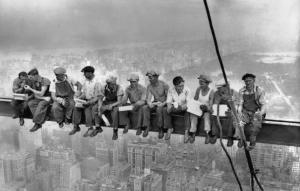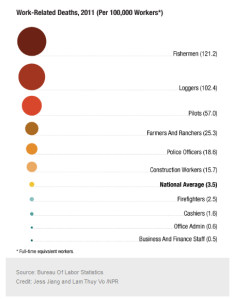 Occupational gender segregation matters and can be attributed to a number of factors. But, a significant factor is cultural. Jobs are gendered. Often not in any necessarily straight-forward way, but jobs acquire gendered attributes and meanings. In fact, occupational gender segregation probably plays a key role in producing our understandings of what is “masculine” or “feminine” in the first place. As Joan Acker famously argued, the “abstract worker” is imagined to be a man (here). This idea is perpetuated in a variety of ways—through formal and informal workplace policies, through curricular gender segregation as areas of study acquire “gendered” meaning, through the ways we frame the work itself as demanding a “masculine” or “feminine” strengths and/or sensibilities, and often, through things as simple as job titles.
Occupational gender segregation matters and can be attributed to a number of factors. But, a significant factor is cultural. Jobs are gendered. Often not in any necessarily straight-forward way, but jobs acquire gendered attributes and meanings. In fact, occupational gender segregation probably plays a key role in producing our understandings of what is “masculine” or “feminine” in the first place. As Joan Acker famously argued, the “abstract worker” is imagined to be a man (here). This idea is perpetuated in a variety of ways—through formal and informal workplace policies, through curricular gender segregation as areas of study acquire “gendered” meaning, through the ways we frame the work itself as demanding a “masculine” or “feminine” strengths and/or sensibilities, and often, through things as simple as job titles.
The feminist movement fought long and hard to have firemen referred to as firefighters, policemen as police officers, etc. The lack of gender-neutral language was a subtle, but symbolic, way through which women were culturally excluded from certain occupations (even in cases where no laws or formal policies necessarily precluded women’s entry). This is a shift that is–to put it mildly–incomplete. For instance, many high schools, colleges and universities still refer to incoming cohorts of students as “freshmen,” while others have opted for the more gender-neutral language of “first-years” (though not without the occasional backlash).
Language is important. It’s a small part of a larger system of power and inequality that helps to organize our lives. Legal feminist scholars have asked that we rid ourselves of language in laws that reflect gender bias. I know what you’re thinking, but it’s more complicated that clicking Command+F and either replacing “men” with “people” or “men and women” and adding “/she” to the “he’s” or replacing them with “them/their” instead. The tricky part has been when we literally lack gender-neutral language for something. As one journalist put it, “Some gender-specific words just aren’t that easy to replace” (here). While firefighter, police officer, and first-year might have been interpreted as easy changes, more difficulty surrounded words and positions like: ombudsman, penmanship, servicemen.
 And this brings us to the “manhole.”
And this brings us to the “manhole.”
Continue reading

